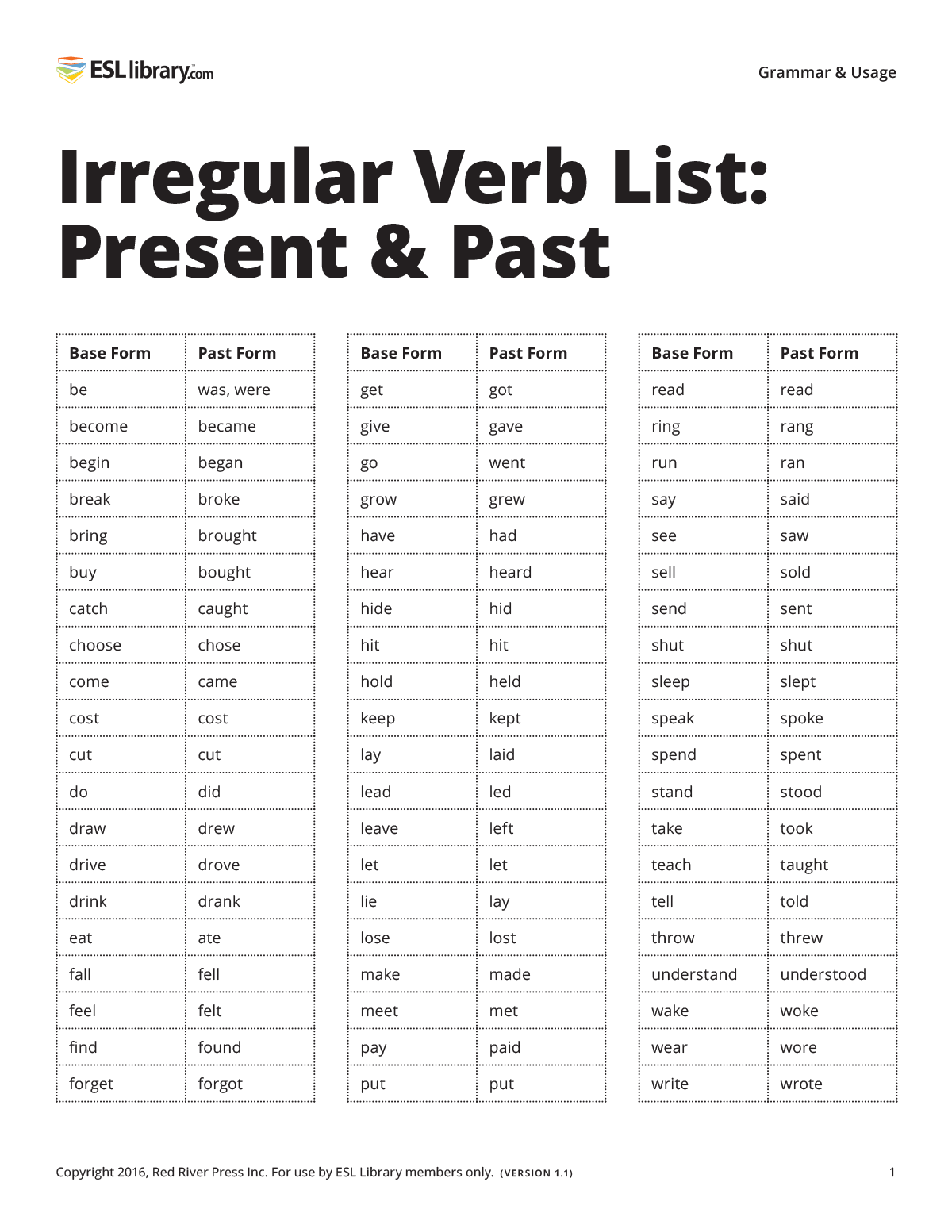Share this post
In English, the simple past tense is formed by adding -ed to the end of the regular verbs. If only all past verbs were that easy! The problem for English language learners is the many, many changes that occur when forming the past tense of irregular verbs.
Sometimes the vowel changes (come → came), sometimes the pronunciation changes (read → read), and sometimes the whole word changes (eat → ate). Sometimes there seems to be a pattern (throw → threw, know → knew), but there are always exceptions (snow → snowed).
English language learners can become discouraged with what they perceive as the endless memorization ahead of them, so English teachers can help by introducing fun activities for learning and reviewing irregular verbs. When one of our subscribers asked us for some ideas for irregular verb activities, I was only too happy to share my five favorites. Please add to the list and share your favorite activity in the comment section below!
Activities
1. Irregular Verb Ball Toss
Let’s start with a quick and easy one that always goes over well with my students. Bring in a rubber ball (or use a small eraser, a scrunched-up ball of paper, or anything else that’s light and safe to throw) and let the game begin! You may want to let students refer to a list of irregular verbs when they’re first learning them, but later on you can play it without the list. I prefer not to keep score during this game, but you may choose to. You can also choose if you should correct any mistakes or if another student should do it.
- Choose an irregular verb and say the base form out loud.
- Say the name of a student and toss the ball to them.
- The student must catch the ball and say the past form.
- That student then chooses another verb and repeats the steps above.
- Continue until all the students have had a turn or two.
2. Concentration
(on the table)
This classic game is useful for reviewing all kinds of vocabulary and grammar targets. Cut up the verbs from the list (one set for each group) or make your own verb cards. You could also have students make their own cards.
- Arrange students into small groups (groups of three or four work well).
- Mix up the verb cards and arrange them facedown in a rough square pattern.
- One student starts by turning over any two of the cards. If that student gets a match (by turning over a base verb that matches the past form of that verb), he/she can keep the pair of paper slips. If there’s no match, the student must turn the slips over again and place them back in the same place.
- Once all the slips have been matched up, students should add up how many pairs they have. The student with the most matches wins!
3. Concentration
(on the board)
This activity is my favorite for irregular verb review. It always goes over well and gets the whole class involved.
- Draw a grid on the board with 20 squares (5 × 4). Write the numbers 1–20 in the top left‑hand corner of each square. Have a master grid for yourself that you can refer to with ten base verbs and ten corresponding past forms (use the list below for ideas) filled into the grid (one verb per square, with the order mixed up).
- Divide the students into two teams. Ask one student from team A to choose one box. Write the verb in the center of the box. Have that same student choose another box. Fill in that box too.
- If the two boxes create a match (base verb + past verb), leave the verbs written in the boxes and give that team a point. If they don’t match, erase both boxes and repeat the process with a student from team B.
- Continue until all the boxes are filled in. For the last pair of boxes, make it more challenging by having that team member guess the last box (i.e., if the base verb is chosen, write it in the box, but then the student must tell you the past form without seeing the last box, and vice versa). The team with the most points wins!
Note
Most boards will clearly show which spots have been erased, thus making it easier for students to remember which numbers have already been chosen. To make it more challenging, when setting up the board, run the eraser over the center of each box before starting the game.
4. Bingo
Bingo is another classic, popular game that’s easy to adapt for irregular verb review.
- Make a copy of a blank Bingo card for each student.
- Have students fill in the past form of any verbs from the list below (one inside each square) in any order. The center square can be a “free” space, if you wish.
- Tell students they can yell out “Bingo!” when they have one horizontal, vertical, or diagonal line checked off. Higher‑level students must complete two lines.
- Using the list, call out the base form of the verbs in a random order, one by one. Students can check off the past verbs that match.
- Continue until a student yells “Bingo!”

Warm-Ups & Fillers – Bingo
5. Relay
Relay races are quick and easy to do, and they get your students moving!
- Write two (or more, if you want more than two teams) columns of base verbs from the list on the board before class starts. The columns should be identical. (For a more challenging race, choose other, less common verbs.)
- Divide the class into two (or more) teams.
- Move desks and chairs out of the way.
- Line students up facing the board.
- When you yell “Go!”, the first student from each team must run to the board and write the past form of any one verb next to the base form.
- That student then races back and hands the marker or chalk to the next student in line. Continue until one team has all the verbs filled in.
- Give each team one point for each correctly formed (and spelled!) past verb.
Irregular Verb List

Grammar & Usage – Irregular Verb List: Present & Past
Practice
Try our Grammar Practice Worksheets, Simple Sentences, and Grammar Stories sections for a variety of lessons on the simple past.
Comments (29)
Paola G.(Teacher)
March 2, 2015 at 7:30 pm

Tanya Trusler(Author)
March 2, 2015 at 11:08 pm
lindsaay (Guest)
March 10, 2015 at 8:49 am
Anonymous A.(Teacher)
March 10, 2015 at 9:30 am

Tanya Trusler(Author)
March 10, 2015 at 10:48 pm
Farid B.(Teacher)
April 29, 2016 at 11:27 pm

Tanya Trusler(Author)
May 5, 2016 at 1:56 am
guest (Guest)
January 25, 2017 at 8:02 pm

Tanya Trusler(Author)
January 26, 2017 at 2:01 am
Anonymous A.(Teacher)
May 24, 2020 at 11:32 am

Tanya Trusler(Author)
May 25, 2020 at 10:56 pm
Hana (Guest)
January 26, 2017 at 12:52 pm

Tanya Trusler(Author)
January 26, 2017 at 11:20 pm
Erasmo (Guest)
March 11, 2017 at 5:53 pm

Tanya Trusler(Author)
March 13, 2017 at 10:03 pm
Johnny (Guest)
March 16, 2017 at 10:04 pm

Tanya Trusler(Author)
March 17, 2017 at 12:50 am
Ximena Sanjinés(Guest)
September 1, 2017 at 5:31 pm

Tanya Trusler(Author)
September 2, 2017 at 12:48 am
Joe (Guest)
September 20, 2017 at 10:42 pm

Tanya Trusler(Author)
September 22, 2017 at 11:08 pm
Anonymous A.(Teacher)
January 11, 2018 at 9:14 pm

Tanya Trusler(Author)
January 12, 2018 at 12:07 am
Merce (Guest)
February 18, 2018 at 6:29 pm

Tanya Trusler(Author)
February 21, 2018 at 3:00 am
maria santiago(Guest)
June 26, 2018 at 7:59 am

Tanya Trusler(Author)
July 2, 2018 at 10:16 pm
Thao Trang Vu(Guest)
September 10, 2018 at 7:44 pm

Tanya Trusler(Author)
September 10, 2018 at 11:39 pm
Victoria Sayapina(Guest)
November 21, 2018 at 8:56 am

Tanya Trusler(Author)
November 21, 2018 at 11:30 pm
Irina L.(Teacher)
November 10, 2019 at 3:15 pm

Tanya Trusler(Author)
November 19, 2019 at 7:38 pm
Anonymous A.(Teacher)
May 24, 2020 at 11:35 am

Tanya Trusler(Author)
May 25, 2020 at 10:54 pm
Dan Growsber(Guest)
September 15, 2020 at 7:59 pm
Tammy Wik(Ellii Staff)
September 16, 2020 at 4:49 pm
Filip Bizjak(Guest)
March 2, 2021 at 6:00 pm
Lei Kayanuma(Ellii Staff)
March 2, 2021 at 7:20 pm
Leelapan P.(Teacher)
March 3, 2021 at 2:13 am
Lei Kayanuma(Ellii Staff)
March 3, 2021 at 3:20 pm
Stephanie G.(Teacher)
September 29, 2021 at 4:17 pm
Lei Kayanuma(Ellii Staff)
September 29, 2021 at 5:20 pm

Tanya Trusler(Author)
September 29, 2021 at 5:40 pm
mulugeta weldearegay(Guest)
October 9, 2022 at 2:55 am

Tanya Trusler(Author)
October 12, 2022 at 12:02 am
Emna Hamza(Guest)
March 9, 2023 at 9:13 pm
Pierre Sekene BAKHOUM(Guest)
October 8, 2023 at 11:07 am

Tanya Trusler(Author)
October 10, 2023 at 11:26 pm
Shereen H.(Teacher)
August 19, 2024 at 12:44 am

Tanya Trusler(Author)
August 19, 2024 at 3:47 pm
Jessica (.(Teacher)
February 6, 2025 at 4:31 pm

Tanya Trusler(Author)
February 7, 2025 at 9:06 pm
Jessica (.(Teacher)
February 10, 2025 at 10:12 am
